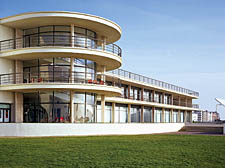|
|
 |
| |

De La Warr Pavilion in Bexhill |
‘Pavilion shows the way to save health centre’
Businessman calls for trust to be set up
IT is a striking example of international modernism, built in the 1930s by visionary architects but the victim of decades of neglect until it was restored to its former glory.
The historical parallels between the De La Warr Pavilion in Bexhill, East Sussex, and Finsbury Health Centre are inescapable.
Could the transformation of the seaside pavilion hold the key to the future of Berthold Lubetkin’s iconic grade I-listed building, which is threatened with closure?
Businessman Dr Richard Sykes, who helped save the pavilion, gave evidence to Islington Council’s Health and Wellbeing Scrutiny Committee last night (Thursday).
He revealed this week how the pavilion was saved: “The local council was spending £1.5million out of their £10m budget on maintaining the pavilion.
“They said it couldn’t continue – it was going to be sold to JD Wetherspoon at one point. Politically, the pavilion became a hot potato.”
Dr Sykes, who lives in Islington, was instrumental in setting up a charitable trust that took charge of the modernist building designed by renowned architects Erich Mendelsohn and Serge Chermayeff in 1935. It was transferred from the ownership of Rother District Council to the DLWP Charitable Trust in 2004 on a 99-year lease.
Backed by £8m from the Heritage Lottery Fund and the Arts Council, the pavilion has reopened as one of the leading contemporary arts centres and galleries in the country.
NHS Islington, like Rother Council, argues that money for refurbishing the Grade I-listed Finsbury Health Centre would be better spent elsewhere. It maintains it is not its place to safeguard the architectural heritage of Islington, only to serve its patients.
Dr Sykes said: “What NHS Islington is saying is that because the health centre is Grade I-listed, they cannot afford to maintain it – and that NHS funds would be better spent on other things. How the pavilion relates to them is that if a similar trust was set up, it could take away the cost of the building. It could leave Islington with a refurbished building at no more cost than they were spending originally.”
Labour councillor Martin Klute, who was asked by former Health Secretary Alan Johnson to investigate the future of the Pine Street centre, believes the pavilion option could work.
He told a Town Hall committee meeting last Thursday: “I honestly think we can find an agreement with the primary care trust that means we can preserve the building and provide better healthcare for Islington patients.”
NHS Islington says complicated Department of Health financial regulations mean any refurbishment must be done through a Lift scheme, where public buildings are handed over to private firms and then rented back over 20 years at high costs.
NHS Islington finance boss Simon Goodwin told the meeting: “It would be £400,000 per year more expensive than renting a building with the same clinical space. It would mean other things would miss out on that money. In the current climate, when it is broadly agreed that the current level of service is going to be difficult to sustain, we must spend our money wisely.” |
 |
|
|
 |
| |
| |
|
 |
|